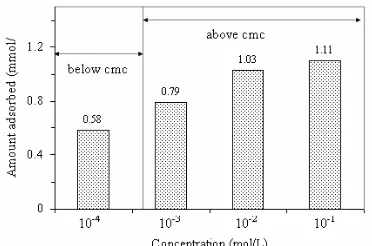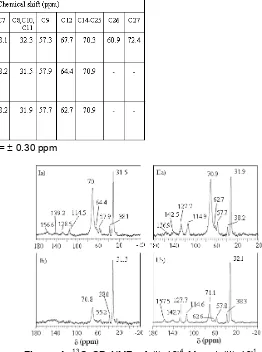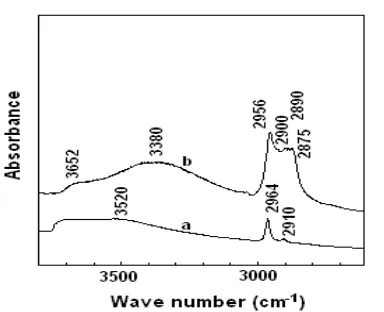* Corresponding author.
FTIR AND NMR STUDIES OF ADSORBED TRITON X-114 IN MCM-41 MATERIALS
Paulina Taba
Department of Chemistry, Hasanuddin University
Jl. Perintis Kemerdekaan Km 10 Tamalanrea, Makassar, South Sulawesi, Indonesia 90245
Received February 26, 2009; Accepted May 12, 2009
ABSTRACT
One source of water pollutions is caused by the high use of surface-active agents (surfactants) by industries and households. As a consequence, it is required to remove such substances from the environment One of the important and widely used methods for removal of substances from solution is adsorption. In this research, MCM-41 and its modification MCM41-TMCS were used to adsorb nonionic surfactant, Triton X-114. FTIR and NMR methods were used to study the interaction between the surfactants and the adsorbents. MCM-41 was synthesized hydrothermally at 100 oC and its modification was conducted by silylation of MCM-41 with trimethylchloro silane (MCM41-TMCS). Both unmodified and modified MCM-41 can adsorb the surfactant. The amount adsorbed in the unmodified material is higher than that in the modified one. The interaction of Triton X-114 with MCM-41 was hydrogen bonding between the silanol groups in MCM-41 and hydroxyl groups of Triton X-114. For modified samples, Triton X-114 interacted with alkylsilyl groups mostly through hydrophobic interaction. It is more likely that the interaction was through C12, C13, C26 and C27 of Triton X-114.
Keywords:FTIR, NMR, adsorbed Triton X-114, MCM-41 materials
INTRODUCTION
The widespread use of surfactants in industries as well as at home is producing an important environmental impact, especially in aquatic media. As a consequence, it is required to remove such substances from the environment. Non-ionic surfactants, such as Triton X-114, have found widespread use in several domestic and industrial applications such as cleaning, personal care, crop protection, paint and coating, textile finishing, emulsion stabilization, food and leather processing, and ore refining. One of the largest applications of these surfactants is in petroleum industries where they find use in the operations involving foams, emulsions and liquid– solid operations such as stabilization of fine particles and sludge displacement [1]. It is well known that surfactants with ramified hydrocarbon chains show high resistance to biodegradation in aqueous media, leading to the formation of long-standing foams. Several days or weeks are required for the complete biodecomposition of surfactants, which often leads to the formation of persistent and even toxic metabolites. Adsorption is one of the important and widely used methods for removal of substances including surfactants from solution. It has been reported that activated carbon and graphite [2,3], unmodified and modified silica [4], silica gel [5,6], mica [7], clays [8], polymers [9-12], and modified zeolite [13] have all previously been used as adsorbents for the removal of surfactants from aqueous environments.
Mesoporous materials, such as mesoporous silica with diameters of 2 to 50 nm, show high promise to be
used as adsorbents for such organic materials because of their high porosity and their large surface areas. One example of mesoporous silica is MCM-41, discovered in 1992 by Mobil Corporation [14,15]. In this research, adsorption of nonionic surfactant (Triton X-114) in MCM-41 and its modification will be discussed. The molecular structure of the surfactant is given as follows:
The amount of surfactants adsorbed was measured from the carbon content of the adsorbent following adsorption. 13C CP MAS NMR and FTIR spectroscopy was used to study the mechanism of interaction between the surfactant and mesoporous materials. The method used for adsorption of the surfactant in mesoporous materials was the stirring method, which has been described in detail elsewhere [16], in aqueous solutions for periods of 5 hours.
EXPERIMENTAL SECTION
Figure 1. Adsorption of Triton X-114 in MCM-41 as a function of concentration
Table 1. The uptake of CTAC in MCM-41 and MCM41-TMCS on a pore volume basis together with the surfactant uptakes in mmol per gram and mmol/cm3.
Amount of Triton
Figure 2. In situ FTIR spectra of (a) calcined MCM-41, (b) MCM-41 after adsorption of 10-4M Triton X-114, and (c) MCM-41) after adsorption of 10-1M Triton X-114.
experiments, a Bomem MB-100 Fourier Transform Infrared (FTIR) spectrometer equipped with a mercury cadmium telluride (MCT) detector was used to obtain infrared spectra of samples. The 29Si spectra were measured on a Bruker MSL-300 NMR spectrometer, using a Bruker 4 mm 4WB-BL probe, a Larmor frequency of 59.61 MHz was used. The sample was spun at a spin rate of 3 kHz and an acquisition time of 21.5 ms.
RESULT AND DISCUSSION
Adsorption of Surfactants in MCM-41 Materials
Before adsorption experiments were undertaken, the hydrostability of MCM-41 was tested by stirring the
materials in water at room temperature for certain periods of time and then the XRD patterns of the materials were recorded. As has been reported in earlier work [19], the structural order of MCM-41 remained unchanged after a stirring period of 5 h, therefore the adsorption can be performed under this condition. The adsorption of Triton X-114 was carried out at concentrations both below and above critical micelle concentration (cmc) for Triton X-114. Figure 1 displays the adsorption as a function of concentration of Triton X-114.
It can be seen that the amount of Triton X-114 adsorbed below the cmc is 0.58 mmol/g, and the amount of the surfactant adsorbed above the cmc is 0.79 mmol/g. This suggests that for Triton X-114, the effect of micellization on surfactant adsorption is much less pronounced, indicating that single molecules of the neutral surfactant are readily adsorbed. This is different compared to adsorbed cationic surfactant cethyltrimethyl-ammonium chloride (CTAC), where MCM-41 (C16) has a higher affinity for the micellar form of CTAC than for single molecules of the surfactant as has been observed in the previous work [19].
Surfactant adsorption experiments were also carried out by Inagaki et al. (1998) using FSM-16, which is a mesoporous silica similar in structure to MCM-41, as an adsorbent. In contrast with the results observed in this study, Inagakiet al.reported that FSM-16 showed a high uptake of micellar surfactants, both cationic and neutral, but very low uptake of both surfactants below their respective cmcs. The neutral surfactant used by Inagaki et al., polyoxyethyleneoctylphenylether, differs significantly from Triton X-114 however, in that it contains no terminal hydroxyl group. This question of how Triton X-114 single molecules interact with the MCM-41 adsorbents is considered further below. For the purposes of comparing the amount of the surfactant adsorbed by unmodified and modified MCM-41, a standard surfactant concentration of 10-1 M was employed in experiments. The amount of surfactants adsorbed in unmodified and modified MCM-41 at this concentration is presented in Table 1. Modification of MCM-41 with TMCS decreased slightly the uptake of the surfactant. This is due to the decrease of pore volume of the surfactant after being modified with TMCS.
FTIR and NMR Studies of Adsorbed Triton X-114 in MCM-41 Materials
Table 2.Chemical shifts of Triton X-114 peaks in solution and in calcined MCM-41 after adsorption of 10-4M and 10 -1
M of the surfactant.
Uncertainty in chemical shift =0.30 ppm
Figure 3. 13C NMR spectra of (a) Triton X-114 solution (in D2O), (b) calcined MCM-41 after adsorbed 10-4 M Triton X-114 and (c) calcined MCM-41 after adsorbed 10-1M Triton X-114. The solid samples (b and c) were measured with1H cross polarization.
cm-1is also perturbed and shifts to lower wave number, centered at 3350 cm-1. This strongly suggests that the interaction is due to the hydrogen bonding between the hydroxyl groups in Triton X-114 and the silanol groups of MCM-41. Similar results were observed by Maeda,et al.
[5], who examined immobilization of enzyme in molecular assembly of nonionic surfactant adsorbed on silica gel. It was found that the interaction between the hydrophilic group of Triton X-100 [C8H17-C6H4-(OCH2)9-10-OH and silica gel surface was mainly due to hydrogen
Figure 4. 13C CP NMR of (I) 10-4 M and (II) 10-1 M Triton X-114 adsorbed in MCM-41 as different contact times: (a) 2 ms and (b) 5 ms.
bonding.13C CP NMR spectra of adsorbed Triton X-114 in MCM-41 are presented in Figure 3. There are 11 peaks observed in the solution NMR spectrum. From literature [20], 17 peaks were obtained. Here, peaks C8, C10 and C11, which have similar chemical shift, appear as one peak whereas in the literature they were resolved. The chemical shifts of peaks found in 13C NMR of Triton X-114 in solution and in MCM-41 materials are tabulated in Table 2. There is a general broadening of all peaks relative to the solution spectrum, particularly in the region 60-80 ppm. The broadening and loss of resolution of peaks due to carbons 26 and 27 is consistent with the suggested interaction of the hydroxyl end of the molecule with the MCM-41 pore walls.
Figure 5. In situ FTIR of adsorbed Triton X-114 in MCM41-TMCS before (a) and after (b) adsorption.
difference observed when different contact times were used, is that the intensity of the peak at 70.9 ppm (C14-C25) using the 5 ms contact time is lower than that using the 2 ms contact time. The intensities ratio of C14-C25 to C8, C10, C11 using the large contact time is about 3 times higher than that using the small contact time for both concentrations. This suggests that there is a difference in the effectiveness of cross polarization with the different contact times. The cross polarization of C14-C25 at a contact time of 5 ms is less effective than that measured at a contact time of 2 ms, implying mobility of C14-C25 is higher than that of C8, C10 and C11. Another difference observed is that for the concentration of 10-4 M, several peaks at higher chemical shift (peaks of carbon in the benzene ring) can not be seen when the measurement was performed using a contact time of 5 ms. This indicates that proton cross-polarization to the aromatic carbons does not occur efficiently in the adsorbed species due to the motion of the aromatic head group of Triton X-114 within the pore of MCM-41.
FTIR spectra of Triton X-114 in modified MCM-41 can be seen in Figure 5. There is an increase in intensity of the C-H bending mode in modified MCM-41 after Triton X-114 adsorption, indicating an interaction between modified MCM-41 and Triton X-114. There is also shift in the broad peak centered at 3520 cm-1to the broad peak centered at 3380 cm-1 observed. This may be caused by hydrogen bonding between Triton X-114 molecules containing OH groups or between OH groups of Triton X-114 and water molecules.
13
C CP NMR spectra of Triton X-114 in modified MCM-41 are presented in Figure 6. The peak of methyl groups in MCM41-TMCS (at -1.5 ppm) is perturbed and shifted to higher chemical shift (at 1.3 ppm). It is also noted that the peaks of Triton X-114 in MCM41-TMCS, particularly C27 (72.4 ppm), C12 (67.7 ppm) and C26 (60.9 ppm), are influenced by these interactions. The peak of C27 is not well resolved for the modified sample and peaks at 67.7 and 60.9 ppm shift to 61.6 and 57.3 ppm for MCM41-TMCS. These results confirm that there
Figure 6. 13C CP NMR of (a) MCM41-TMCS and (b) MCM41-TMCS after adsorption of 10-1M Triton X-114.
is a hydrophobic interaction between the methylsilyl group and Triton X-114, more likely with C12, C26, C27 and maybe also with C13. The lack of resolution of the C27 peak may be caused by hydrogen bonding between OH groups, attached to C27 in the molecules of Triton X-114.
CONCLUSION
From the results observed above, it can be summarized that both unmodified and modified MCM-41 can adsorb the nonionic surfactant (Triton X-114). The interaction of Triton X-114 with MCM-41 was hydrogen bonding between the silanol groups in MCM-41 and hydroxyl groups of Triton X-114. For modified samples, Triton X-114 interacted with alkylsilyl groups mostly through hydrophobic interaction. It is more likely that the interaction was through C12, C13, C26 and C27 of Triton X-114.
ACKNOWLEDGEMENT
The author would like to express sincere thanks to Professor Russell F. Howe and Dr. Grainne M. Moran for their excellent supervision, encouragement, and valuable discussion throughout this research. This investigation was funded by AUSAID to carry out the research work in the University of New South Wales, Australia.
REFERENCES
1. Schramm, L.L. and Marangoni. D.G., “Surfactants and their solutions: basic principles” in
Surfactants: Fundamentals and Applications in the Petroleum Industry. Eds. Schramm, L.L., Cambridge University Press, Cambridge, 2000, 3-50.
2. Wanless, E.J. and Ducker. W.A., 1997,Langmuir,
3. Wanless, E.J., Davey, T.W., and Ducker, W.A., 1997,Langmuir, 13, 4223-4228.
4. Chorro, M., Vhorro, C., Dolladille, O., Partyka, S., and Zana, R., 1999, J. Colloid Interface Sci., 210, 134-143.
5. Maeda, R., Tomida, H., Matsumoto, M., and Kondo, K., 1997,J. Chem. Eng. Jpn., 30,910-915.
6. Zaporozhets, O.A., Nadzhafova, O.Y., Verba, V.V., Dolenko, S.A., Keda, T.Y., and Sukhan,V.V., 1998,
Analyst, 123,1583-1586.
7. Ducker, W.A. and Wanless, E.J., 1999, Langmuir,, 15,160-168.
8. Blokhus, A.M., Høiland, H., and Gierde, M.I, 1996,
J. Colloid Interface Sci., 179,625-627.
9. Yamagiwa, K., Sasaki, T., Takesono, S., and Ohkawa, A., 1995, J. Chem. Eng. Jpn., 28, 697-702.
10. Zhao, J. and Brown, W., 1996,J. Phys. Chem., 100, 3775-3782.
11. Fox, G.J., Bloor, D.M., Holzwarth, J.F., and Wyn-Jones, E., 1998,Langmuir, 14,1026-1030.
12. Maroto, J.A., and Nieves, F.J.D.I., 1998, Colloids Surf., A., 145, 271-279.
13. Kawai, T. and Tsutsumi, K., 1994, Colloid Polym. Sci., 272,830-835.
14. Beck, J.S., Vartuli, J.C., Roth, W.J., Leonowics, M.E., Kresge, C.T., Schmitt, K.D., Chu, C.T.W.,
Olson, D.H., Sheppard, E.W., McCullen, S.B., Higgins, J.B., and Schlenker. J.L., 1992. J. Am. Chem. Soc., 114, 10834-10843.
15. Kresge, C.T., Leonowicz, M.E., Roth, W.J., Vartuli, J.C., and Beck, J.S., 1992,Nature359, 710-712. 16. Inagaki, S., Ogata, S., Goto, Y., and Fukushima,
Y., “Mesoporous Materials Derived from Layered Silicates and the Adsorption Properties” In
Mesoporous Molecular Sieve, Stud. Surf. Scie. Catal. Vol. 117, Elsevier, Baltimore. Eds. Bonneviot, L., Béland, F., Danumah, C., Giasson, S., and Kaliaguine, S., 1998, 65-76
17. Kim, J.M., Kwak, J.H., Jun, S., and Ryoo, R., 1995,J. Phys. Chem., 99, 16742-16747.
18. Fraile, J.M., Garcia, J.I., Gracia, D., Mayoral, J.A., Tarnai, T., and Figueras, F., 1997, J. Mol. Catal. A: Chem., 121, 97-102.
19. Taba, P., Russell, R.F., and Moran, G., 2008,
Indo. J. Chem., 8, 1-6.


